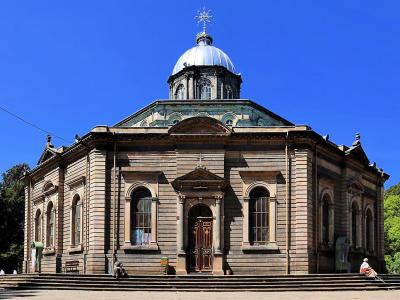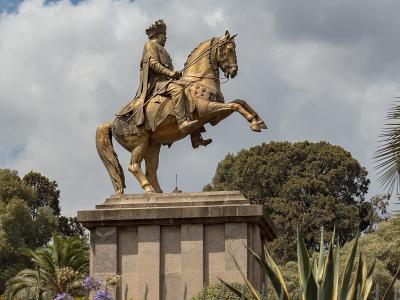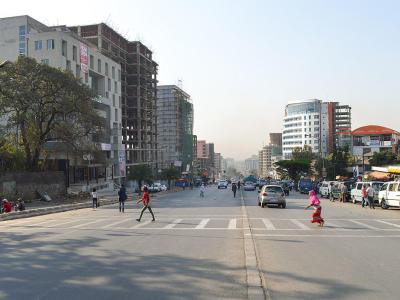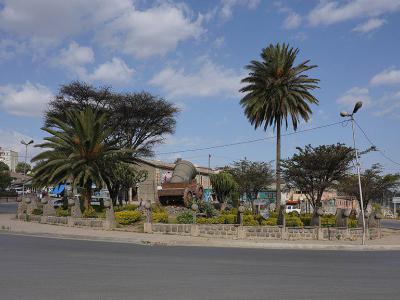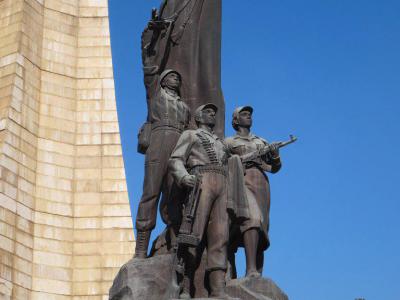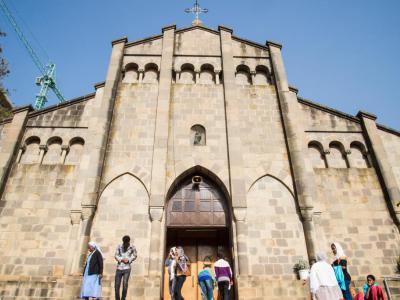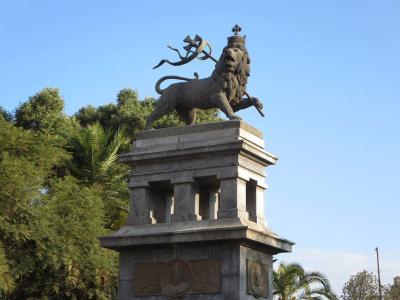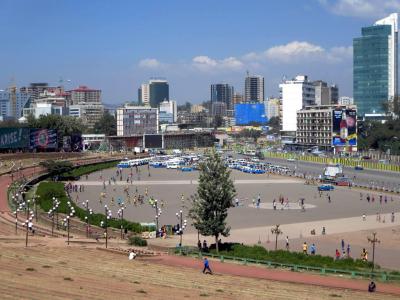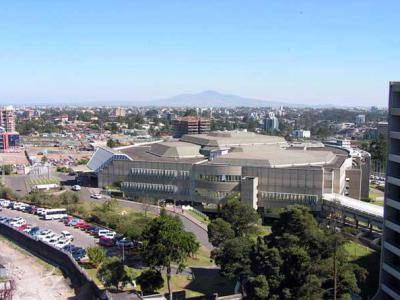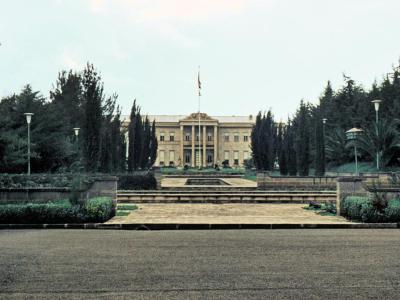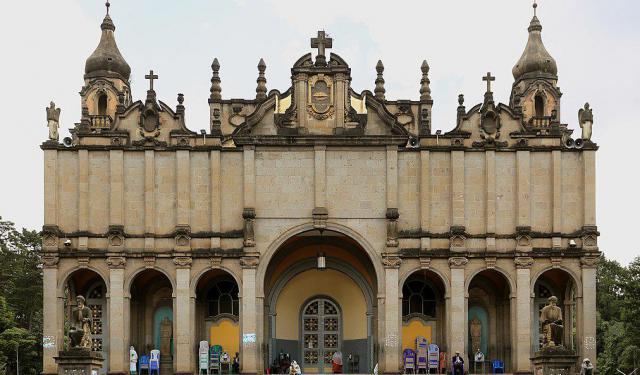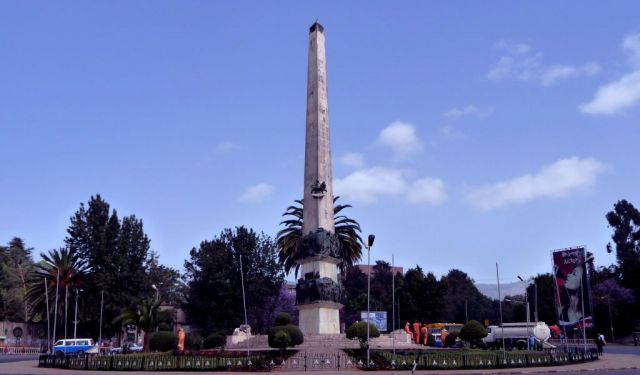
Addis Ababa Introduction Walking Tour (Self Guided), Addis Ababa
Addis Ababa, the capital of Ethiopia, is the country’s commercial and cultural hub, hosting a number of historic landmarks: monuments, squares, palaces and more. Among them the ones dedicated to the local Emperor Menelek and those commemorating the country's last, 20th-century emperor Haile Selassie. Follow this orientation walk to explore some of the top attractions of Addis Ababa.
How it works: Download the app "GPSmyCity: Walks in 1K+ Cities" from Apple App Store or Google Play Store to your mobile phone or tablet. The app turns your mobile device into a personal tour guide and its built-in GPS navigation functions guide you from one tour stop to next. The app works offline, so no data plan is needed when traveling abroad.
Addis Ababa Introduction Walking Tour Map
Guide Name: Addis Ababa Introduction Walking Tour
Guide Location: Ethiopia » Addis Ababa (See other walking tours in Addis Ababa)
Guide Type: Self-guided Walking Tour (Sightseeing)
# of Attractions: 10
Tour Duration: 3 Hour(s)
Travel Distance: 5.4 Km or 3.4 Miles
Author: vickyc
Sight(s) Featured in This Guide:
Guide Location: Ethiopia » Addis Ababa (See other walking tours in Addis Ababa)
Guide Type: Self-guided Walking Tour (Sightseeing)
# of Attractions: 10
Tour Duration: 3 Hour(s)
Travel Distance: 5.4 Km or 3.4 Miles
Author: vickyc
Sight(s) Featured in This Guide:
- St. George's Cathedral
- Menelik II Statue
- Churchill Avenue
- Tewodros Square
- Derg Monument
- San Salvador Church
- Lion of Judah
- Meskel Square
- Africa Hall
- National Palace
1) St. George's Cathedral (must see)
St George's Cathedral is an Orthodox cathedral noted for its distinctive octagonal form and is located at the northern end of Churchill Road. Designed by Sebastiano Castagna and built by Italian prisoners of war defeated at Adwa in 1896, it was named after St. George, after the ark of the church was carried to the Battle of Adwa against the Italians, during which the Ethiopians secured victory. The Italian Fascist authorities set the building on fire during the war in 1937, yet the cathedral was later restored by the Emperor following the liberation in 1941.
The Cathedral has a museum where it displays an Imperial throne and weaponry used in the wars against the Italians including curved swords and tridents and giant helmets made from the manes of lions.
The Cathedral has a museum where it displays an Imperial throne and weaponry used in the wars against the Italians including curved swords and tridents and giant helmets made from the manes of lions.
Sight description based on Wikipedia.
2) Menelik II Statue
This is a monument to one of the greatest emperors in the city centre. This emperor established the city of Addis Ababa. Menelik II Statue is a statue of the emperor sitting gloriously on a horse, and has been standing there since 1930. The statue was erected in memory of the battle of Adowa. This was the only major battle in the history of Africa, when Emperor Menelik and his army defeated the Italian army. The victory of Adowa became somewhat of a national fiesta in Ethiopia.
3) Churchill Avenue
Churchill Avenue is one of the main shopping streets in Addis Ababa. There are numerous small shops on and around Churchill Avenue. You can find different Ethiopian crafts like statues, embroidery, pottery, handmade and household goods. Also there are vendors that sell fresh, local fruit.
4) Tewodros Square
Tewodros Square carries the name of emperor Tewodros II. He reigned in Ethiopia in the 19th century. There is an ancient cannon in the middle of the square that stands there as a monument to this emperor, as he wanted to build an armaments industry in the country. This cannon was made by Europeans in Ethiopia and was called Sebastopol. The original cannon lies somewhere in Ethiopia and this one, a copy of it, is made from bronze.
5) Derg Monument (must see)
Derg Monument is a memorial to the most ruthless totalitarian regime in the history of Africa. The Derg, Common Derg or Dergue is the short name of the Coordinating Committee of the Armed Forces, Police, and Territorial Army that ruled Ethiopia from 1974 to 1987. It took power following the ousting of Emperor Haile Selassie I. Embracing communism as an ideology in 1975, the Derg executed and imprisoned tens of thousands of its opponents without trial between 1975 and 1987.
The monument is classified as one of the major landmarks of the city. It is also called Tigilachin Monument. It has a column with a red star at the top. There are statues of 3 soldiers at the column. This monument was received as a gift from North Korea. Currently, the monument grounds are overgrown and the monument has suffered from neglect (which some say is deliberate).
The monument is classified as one of the major landmarks of the city. It is also called Tigilachin Monument. It has a column with a red star at the top. There are statues of 3 soldiers at the column. This monument was received as a gift from North Korea. Currently, the monument grounds are overgrown and the monument has suffered from neglect (which some say is deliberate).
Sight description based on Wikipedia.
6) San Salvador Church
San Salvador is the Roman Catholic Church in Addis Ababa. It is a large round church built from red brick. There is a tall tower, so characteristic of Catholic style. The Catholic Church appeared in Ethiopia many centuries ago. It is very similar to the Ethiopian Orthodox Church in its expressions of faith.
7) Lion of Judah (must see)
Lion of Judah is one of the greatest monuments in Addis Ababa. It was made in the image of a golden statue of the Lion of Judah. The statue is set on a pedestal made from granite. The portraits of the greatest emperors are near the statue as well. From here, the widest street of Addis Ababa - Churchill Avenue begins. This statue has an interesting history. It traveled a lot and was taken to Rome by the Italians. During a ceremony of fascists, an Ethiopian leader killed many Italian fascists when he saw the statue from his country standing in a square in Rome. Lion of Judah represents the ancient monarchy and is today dedicated to that brave Ethiopian patriot.
8) Meskel Square (must see)
Meskel Square is a square in the city of Addis Ababa. It is often a site for public gathering or for demonstrations and festivals, notably, the Meskel Festival from which it takes its name. Concerts, parades, and various other government and public events are also held there.
The word "Meskel" means "cross" and the festival commemorates the moment when the crucifix was revealed to Empress Helena of Constantinople. Following the fall of the monarchy in 1974, Meskel Square was renamed "Abiot" or Revolution Square. It was greatly expanded so that it could accommodate the annual Revolution Day and May Day parades on September 12 and May 1. Three gigantic portraits of Karl Marx, Friedrich Engels and Vladimir Lenin were erected in the square. The national monument in memory of those massacred by the Derg regime in the "Red Terror" of the 1970s has been built at the eastern entrance to the square.
The word "Meskel" means "cross" and the festival commemorates the moment when the crucifix was revealed to Empress Helena of Constantinople. Following the fall of the monarchy in 1974, Meskel Square was renamed "Abiot" or Revolution Square. It was greatly expanded so that it could accommodate the annual Revolution Day and May Day parades on September 12 and May 1. Three gigantic portraits of Karl Marx, Friedrich Engels and Vladimir Lenin were erected in the square. The national monument in memory of those massacred by the Derg regime in the "Red Terror" of the 1970s has been built at the eastern entrance to the square.
Sight description based on Wikipedia.
9) Africa Hall
Africa Hall is a building of great importance for Africa as it symbolizes African independence and an optimistic future for the countries of this continent. Africa Hall is the permanent headquarters of UNECA, the United Nations Economic Commission for Africa. The structure, built in the span of only 18 months, was completed in February 1961. The main feature of the building is its stained glass windows that depict the suffering of many poor people on this continent. You can see the Filwoha springs that flow very close to the Africa Hall. These springs are very beautiful and that is why the emperor decided to found Addis Ababa here.
Along with the Addis Ababa City Hall, Africa Hall was one of the two projects designed to demonstrate, in the words of Emperor Haile Selassie, “that it is possible to construct grand buildings here too [in Ethiopia], by erecting a couple of high-profile structures. It is not their complexity or size that matter, but the maximum possible use of home-produced materials, in order to shake our wealthy middle class (which keeps its money under the mattress) from the inactivity that also binds it in the field of construction, and stimulate it to invest its assets also in building to make this ‘great village’ a city and a true great capital”.
Along with the Addis Ababa City Hall, Africa Hall was one of the two projects designed to demonstrate, in the words of Emperor Haile Selassie, “that it is possible to construct grand buildings here too [in Ethiopia], by erecting a couple of high-profile structures. It is not their complexity or size that matter, but the maximum possible use of home-produced materials, in order to shake our wealthy middle class (which keeps its money under the mattress) from the inactivity that also binds it in the field of construction, and stimulate it to invest its assets also in building to make this ‘great village’ a city and a true great capital”.
Sight description based on Wikipedia.
10) National Palace
A beautiful palace in the center of the city, the National Palace of Ethiopia, was built in 1955 to mark emperor Haile Selassie's Silver Jubilee and was called the Jubilee Palace. The palace was expanded and doubled in size between 1966 and 1967. The Jubilee Palace was the site of the dethronement of Emperor Haile Selassie in September 1974. The Derg renamed the Palace the "National Palace", which it still bears today. With the fall of the Derg, and the proclamation of the Federal Republic, the Jubilee Palace became the official residence of the President of the Federal Republic of Ethiopia. Around the palace there is a beautiful park. The inside design of the palace was made by an Italian designer. The Ethiopian Government announced its intention to build a new official presidential residence. The National Palace will then be opened as a museum. It will continue to house the President of the Republic until that time.
Sight description based on Wikipedia.
Walking Tours in Addis Ababa, Ethiopia
Create Your Own Walk in Addis Ababa
Creating your own self-guided walk in Addis Ababa is easy and fun. Choose the city attractions that you want to see and a walk route map will be created just for you. You can even set your hotel as the start point of the walk.
Religious Buildings
Ethiopia is mainly a Christian country. However, there are many other religions of the world there as the country has many ethnic groups. Addis Ababa boasts very beautiful and old, Christian cathedrals and churches. There are also Catholic churches and mosques in the city. This self-guided tour will lead you to the great religious sights of Addis Ababa.
Tour Duration: 4 Hour(s)
Travel Distance: 9.5 Km or 5.9 Miles
Tour Duration: 4 Hour(s)
Travel Distance: 9.5 Km or 5.9 Miles
North of Addis Ababa Walking Tour
Some remarkable landmarks of Addis Ababa can be found in the north part of the city. There are monuments, beautiful buildings and the zoo where you can see lions walking. This self-guided tour will lead you through these attractions in the north of Addis Ababa.
Tour Duration: 2 Hour(s)
Travel Distance: 4.3 Km or 2.7 Miles
Tour Duration: 2 Hour(s)
Travel Distance: 4.3 Km or 2.7 Miles
The Most Popular Cities
/ view all
